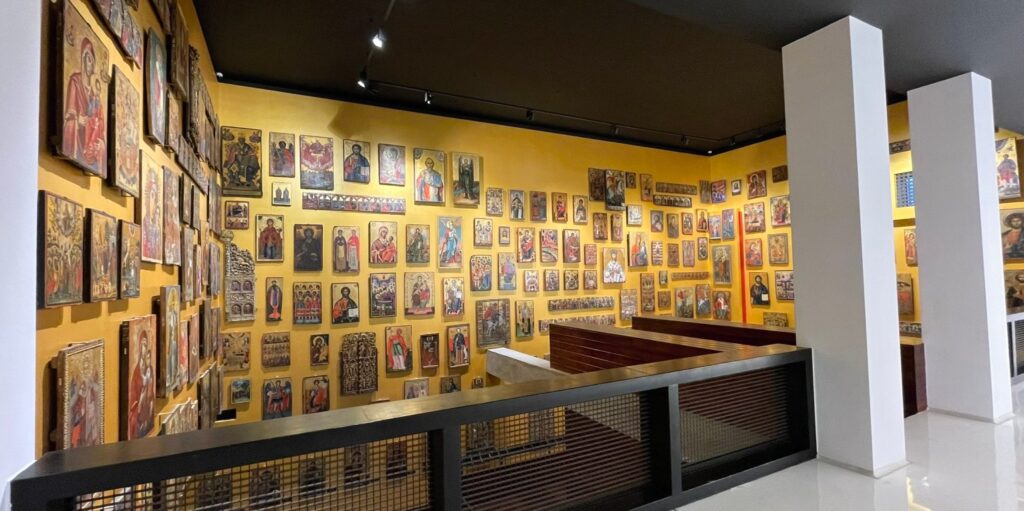Korçë (or Korça) is the most important city of southeastern Albania and a crossroad of the routes to Greece and North Macedonia. The residents are rightfully proud of their city’s heritage and culture as it served as the centre of the Albanian national awakening movement in the 19th and 20th centuries. Some major museums provide proof of this. There are several festivals held throughout the year, with the most intriguing being the beer festival in August. The surroundings also have a lot to offer: visit the village of Voskopojë, with its five churches covered in frescoes. For nature enthusiasts, the Bredhi i Drenovës protected landscape is a great option.
6 things not to be missed in Korçë
|
You should set aside at least one full day to visit the city of Korçë. If you plan to explore the surroundings as well, you won’t get bored even after a week. Keep in mind that due to its high altitude (850 metres) and location in a mountain basin, it is much colder than in the rest of Albania. What is pleasantly cool in summer is bitterly cold in winter.
As is the case with many other Albanian cities and villages, the name Korçë is of Slavic origin. The neighbouring Macedonians call the town Gorica, meaning small mountain. The Greeks name it Koritsa.
Because of its culture and aristocratic grace, which are evident in both its architecture and peoples’ behaviours, Korçë is known as the “Little Paris” of Albania. It is also commonly referred to as “The City of Serenades“, because of the romantic ballads that men used to perform in their homes’ courtyards and balconies.
History of Korçë
The earliest mention of Korçë appears in documents from 1280, but after that, there are no more references in the literature until the Ottoman conquest in the 15th century. Iljaz bej Mirahori, an Albanian military commander under the Turkish sultan who rose to prominence during the 1453 conquest of Constantinople, laid the foundation for the modern city and was put in charge of it. A monument to his era is the mosque from 1494, which still bears his name and is one of the oldest in Albania.
Several centuries of prosperity followed, with Korçë gaining importance within the Ottoman Empire due to its strategic location on trade routes as well as the tradition of craftsmanship. In the 18th century, this rise was further enhanced by the arrival of people from the nearby important cultural and economic centre of Voskopojë, which had been disrupted by conflicts between the Christian and Muslim communities.
A crucial period of the town’s history occurred in the 19th century when Korçë – thanks to being economically developed and having contacts with the world – became the centre of the Albanian national awakening (Rilindja Kombëtare). In 1887, the first school in the Albanian language (Mësonjetorja) was established here. Today, the building houses the Museum of Education.

The strengthening of Albanian national awareness, in parallel with the weakening of the Ottoman Empire, resulted in increasing ethnic conflicts between Albanians and Greeks. After the city was liberated from Ottoman rule during the First Balkan War (1912), a de facto civil war broke out, forcing many people to flee. The most frequent destination for emigrants was the USA, where the Orthodox population went, while Muslims fled mostly to Istanbul.
Although the Great Powers assigned Korçë to the newly formed Albania in 1912, the city was claimed by Greece and was repeatedly occupied by its army. The French garrison helped stabilize the situation, declaring the protectorate Autonomous Province of Korçë in 1916-1920. The French left behind the famous lyceum, where the later communist dictator Enver Hoxha worked as a teacher.

Transport to Korçë
There are frequent buses to Korçë running from Tirana (TEG terminal) via Elbasan and Pogradec (11:00, 12:00, 13:00, 14:00, 15:00 and 16:00). In the opposite direction, the buses leave Korçë for Tirana at 4:30, 6:45, 7:30, 8:30, 9:30 and 10:30. The journey takes about 3.5 hours.
There are also direct buses to Durrës (9:30, returning 14:00), Fier (08:30, returning 15:50), Vlorë (9:00, returning 07:15 the next day), Berat (10:00, returning 15:00), Elbasan (7:00, returning 11:00), Sarandë (Mondays and Fridays 6:00, returning Tuesdays and Saturdays 5:30) and Gjirokastër (Wednesdays and Fridays 6:00, returning Thursdays and Saturdays 7:00).
Regional minibuses take you from Korçë to Bilisht (at least 4 times a day), Ersekë (several times a day), Voskopojë (several times a day) or Prespa Lake (13:00). About every 30 minutes, there are minibuses to Pogradec.
From Greece (Kastoria), there are several buses a day to Korçë. Buses from Thessaloniki to Tirana also make a stop in Korçë.
From the south, Korçë is connected with Përmet with a scenic route through the region of Kolonjë. Driving the narrow, winding and newly asphalted road under the mountains of Gramoz, Ostrovicë and Nemërçkë is an experience in itself. If you are coming from Përmet, avoid the direct route from Çarçovë to Leskovik and take it around the Tre Urat border crossing instead.

Sights in Korçë
Useful Links
Accommodation
Use Booking.com to find the best places to stay in Korçë.
Flights
Find the cheapest flights to Albania on Kiwi.com. It combines various airlines into a single itinerary.
Car Rental
Discover Albania with cheap & reliable car rentals through Rent from Locals.
Mobile data
Airalo provides affordable and convenient mobile data to keep you connected wherever you travel. Forget local SIM or roaming charges.
Experiences
Book a day trip to Korçë on Viator.com.














